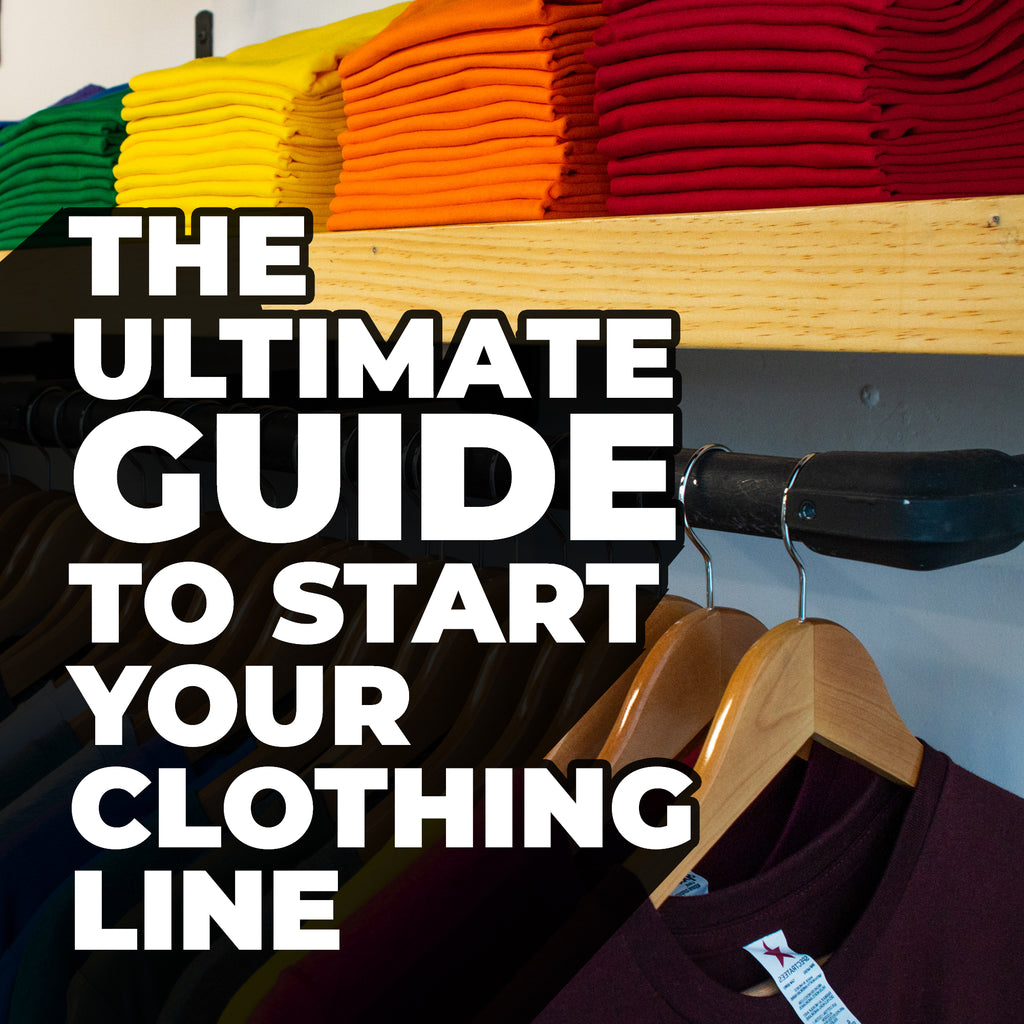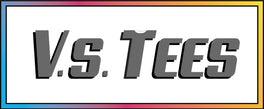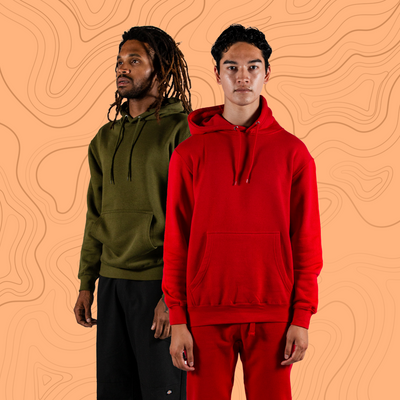The Ultimate Guide To Starting Your Clothing Line
Posted by VS TEES

STEP 1: Pick A Business Model

To launch a successful clothing line, you need to do more than just print off a few t-shirts and sell them online. You'll need a business plan, a clear concept, and a strategy to bring your business to life.
You must first implement a plan for bringing your product to market. A comprehensive business model is an essential step for any business venture.
Below are the four main options you'll want to consider as your business model for your clothing line, as they range widely in price and usefulness.
Print-On-Demand
With print on demand, you and your supplier cooperate in personalizing blank-label goods like Bella + Canvas T-shirts or sport caps with your design so that you may sell them on an as-needed basis under your brand.
This eliminates the need to pre-purchase or stockpile the product, as you won't be required to pay for it until after it has been sold.
Compared to the other three alternatives, this one is also the simplest.
PROS of Print-On-Demand
- You want a quick turnaround of printing clothing.
- You look for possibilities to create designs for various garments, from t-shirts to tote bags, to caps, etc.
- You have a minimal budget to spend. Since there are no initial costs, even fulfilling a few orders may be done at a reasonable rate.
- You don't want to be bound by color limitations.
CONS of Print-On-Demand
- Since you'll be utilizing ordinary wholesale clothing, you won't have much of a say in the quality of the fabric, the stitching, the sizing, etc.
- Lesser margins of profit compared to the other business models.
- You won't generally save money when you buy in bulk.
- Larger orders can't be fulfilled economically.
Private Label
The process of starting a private label clothing business model is very similar to that of print-on-demand. There is a requirement for a large number of blank apparel. The following steps are printing the design and putting labels, tags, and other details. Because of this, it is more labor intensive than print on demand.
However, suppose you're willing to invest the time and effort necessary to make your clothing business stand out in the competitive apparel market. In that case, this may be the best option approach for you. The private clothing line business plan has advantages, although it demands more work.
Better Pricing
Private labeling gives you significant pricing power. Private labels let you price and sell items based on your marketing strategy.
Competitive Advantage
Private labels let you advertise your items freely and choose your own customers. Despite acquiring these items from the market, you control the pricing models. You may ask vendors to customize the item for large purchases.
Brand-Driven Benefits
Every brand wants loyal customers, and private labeling lets you grow your brand. Only marketing and packaging are crucial investments in this business model. Brand loyalty helps determine how many units to sell and onboard new items.
PRO TIP
When starting a private label clothing line, we recommend teaming up with a reliable fulfillment service provider. You can take your brand to the next level with the expertise of VS Tees' Brand Development service and their extensive selection of high-quality printing options. Read more about them here.
Dropshipping
With this business model, you only purchase products when a consumer orders them; you don't require inventory, and you're not in danger if the product will not sell. With dropshipping, you have a lot of alternatives. If you're willing to dive in and do adequate research, you'll be able to discover the right match for your clothing line.
How exactly dropshipping works:
- A consumer purchases something from your website
- Your dropshipper prepare and takes care of the package and delivery it straight to your customer.
All the items you post and sell on your website are housed in your dropshipper's warehouse. Although you will be liable for customer support concerns, your dropshipper will usually manage returns. That means you have one less thing to worry about!
If you're on a tight budget, dropshipping is excellent. Many of us do not have the funds for a brick-and-mortar location to house our stocks. This business model offers an ideal solution to that problem.
Furthermore, dropshipping offers far less cost if you want to launch and advertise a new product. You don't have to spend money stockpiling clothes; instead, you may strike the ground running with a wide range of clothing choices from your supplier.
You should also be aware of the following drawbacks of dropshipping:
- Dropshipping might reduce your profit margins since you will likely spend more per item than you would if you kept a large inventory on hand.
- If your dropshipper does not deliver your items on time, it will reflect poorly on you and your business. This can cause dissatisfaction, negative feedback, and a drop in repeat customers and word-of-mouth promotion.
STEP 2: Choose a niche

When entering the world of the clothing business, it's important to choose a niche. This will help your business stand out and attract the right target market without breaking your bank. Focusing on a specific interest group is one of the best ways to build a successful t-shirt business.
When choosing a niche, there are many different things to consider, but doing your research and understanding your audience is crucial. Narrowing your focus too much can also be risky, so include various interests and target markets in your planning. But finding the right niche is one of the best things you can do to ensure the success of your t-shirt business.
For instance, a niche in the animal industry category is hard to sell in the market. You're going to want to tighten it up a little more. An example of a more specific niche would be veterinarians, dog trainers, and Golden Retriever lovers. This way, the niche is targeted to a particular group of people.
STEP 3: Understand Your Market

After selecting a business model for your startup clothing brand, the real work begins. There's a lot more work to be done before your clothing line can start reaping the benefits.
This is the stage at which you must decide on a selling proposition (USP) for these two reasons:
- Promoting your garments online will be a breeze.
- This will set you apart In today's competitive clothing market industry.
Selling to a big audience is a significant challenge for startups, which is why a unique selling proposition (USP) is so important.
Think about how you may tailor your jogging pants to a specific demographic if you want to increase your sales. Examples are extra-warm fleeces for campers. Or the beach-friendly lightweight jogger for customers in a warmer region.
Think about your target audience and how you may make your brand appeal to them specifically. The first step in this procedure is to identify a specific target market. Establishing a set of user personas as part of your business strategy will help you identify your ideal customers.
If you're having trouble identifying your target demographic, consider the following.
- Which style of apparel am I interested in creating?
- Who would buy them?
- How can I differentiate myself from the pack?
- What strategies are they employing?
When you know who you're selling to, you can make your product or service better suit their wants and needs. To top it all off, you'll know precisely what apparel designer or manufacturer you need to hire.
When building a successful clothing line, you must have a firm grasp of your unique selling proposition and intended market.
STEP 4: Register Your Business

After researching your product and target audience, you'll need to complete the relevant paperwork before starting production.
Choose a company entity type: sole proprietorship, LLC, S corp, etc. Every style has perks and drawbacks, so consider which fits your objectives and plans. If you're starting small, consider a sole proprietorship and an LLC or corporation later on.
Depending on your chosen entity type, you may need to register your company with the state. Even if you're not required to, you may submit a Doing Business As (DBA) to register your business name.
You'll also need business licenses and permits to launch your clothing line company. If you're establishing your brand from home, you may need a sales tax license and home occupation permit. Consult state and local authorities to verify you have the proper documents.
Get Employer Identification Number (EIN). Taxes must be paid when launching a clothing line or any business. You'll need an IRS EIN. An EIN isn't necessary for all companies. Still, it can help you file taxes, open a business bank account, and acquire financing.
STEP 5: Make A Unique Branding

Marketing experts will tell you that effective branding is essential to business growth.
Once you've launched your own clothing brand, you'll need to figure out how to differentiate yourself apart from the competition. After all, you won't become New York's leading clothing brand without putting in the effort.
Your company's values, message, and origin story should inform every step of the branding process.
Everything associated with your brand, from the look of your website to how you treat your customers, should reflect the character of your company. Whether you're coming up with a brand name or a marketing strategy, consider how you may draw attention to what makes your clothing business special. Including a logo on finished garments is another way to include your fashion label in production.
STEP 6: Create Your Design

After establishing your unique brand, you need to start creating designs and sourcing talents. This can be the most challenging part of the process for many entrepreneurs starting a clothing line, especially those with no experience working in the wholesale industry. Partnering with an in-house graphic designer supplier might be the perfect solution.
Design is one of the main things that should pop when running your clothing line. It is the first thing customer focuses on when they look at your brand. So, tick the correct box and create an original, high-quality design.
Here’s a cheat sheet on how to make attractive clothing designs from Design Shack
- Keep it Simple.
- Understand Borders or Edges.
- Consider Shirt Color and Imprint Color.
- Shirt Fabric Matters.
- Think About the Cool Factor.
- Be Aware of Graphic Placements.
- Scale and Size Matters.
- Use Vector Artwork.
Your next step after creating your final designs will be to get them on mockup images so customers can see what the final printed shirt will look like. Another option is to model the clothes and photoshoot them in a studio. The process is much longer and more expensive than mockups, but it will give your brand a professional look.
STEP 7: Source High-Quality T-Shirt & Printing Service

Running a clothing line store can be difficult, especially if you do it independently. By partnering with a trusted supplier that helps you work around the production, you can focus on marketing while they handle the nitty-gritty work. This allows you to continue running your business without worrying about day-to-day operations.
Suppose you’re starting low on capital but eager to pursue your clothing line business. In that case, the made-to-order method will save you thousands of dollars.
Start getting orders from your website without shelling excessive cash on inventory. By the time you get your first order, your backend partner will fulfill those orders.
The significant benefit of made-to-order items is they lessen your upfront capital risk. Of course, there’s a challenge with this, too. Finding the right trusted partner to fulfill these orders is the top most.
When partnering with a manufacturer, consider important aspects such as cost, minimum order quantity, shipping time, and quality. Furthermore, you may want to find a supplier with excellent quality blanks. One thing you can do is order sample items and do a quick test. A supplier offering printing services to fulfill your orders is an excellent plus!
STEP 8: Pricing Your Products

You need to decide on a pricing point for your clothing line before officially releasing it to the public. Your initial material and manufacturing expenses will become clearer once you've established these connections, allowing you to set reasonable prices for your clothing line.
It might be challenging to determine a reasonable selling price for your goods when you have to factor in the cost of manufacturing each piece. Introducing your e-commerce business might be a great opportunity, but only if you choose fair pricing for your fashion brand.
To assist you, we have included a checklist of items to include in your financial plan. Some won't apply if you've chosen a print-on-demand, private-label apparel line, or drop shipping business mode.
- Labor Costs
- Samples
- Materials (fabrics, zippers, blanks, hooks, buttons, etc)
- Fuel for business errands
- Shipping/delivery
- Product research and development
- Production costs
After giving this some thought, you'll have a clearer picture of your financial situation and the prices you can set for your items to turn a profit.
Your pricing strategy should maximize profits while attracting a sufficient number of buyers. However, pricing is an area where your market research will come into play; you should have a good idea of your target market, how they spend their money, and how much they would be prepared to pay for your products.
This information is essential for coordinating with prospective garment factories and apparel producers. Just because you're a clothing designer doesn't mean you have to sell your creations for pennies on the dollar. Many shoppers will assume a higher markup when purchasing from a luxury brand. To build consumer trust in your brand, you must price your products or services fairly.
Of course, you're not stuck with the prices you set initially; like with the products you make, you can always go back and make adjustments as you roll out your apparel line.
STEP 9: Decide Where to Sell Your Merch

Now that your merch is ready for the market and has a price strategy in place, you can begin making sales. However, you must first decide where you will sell your products before officially releasing them to the public.
If you think the internet is the ideal place to sell your clothes, you must prepare a website to introduce your products. Starting with your own social media pages and an online store is a good idea.
After introducing your clothing line to the world, you may opt to expand your distribution channels by selling your products on social media or through an online marketplace.
In the long run, selling your clothing line online will be easier and less expensive than opening a physical storefront. If your online business is doing well, you may want to expand into a physical location or sell your products to larger resellers like department stores.
At the very least, before you can open a shop online, you'll need to settle on an e-commerce platform. Since the style of your online shop will significantly impact customers and your reputation as a whole, you should prioritize finding a platform that offers unique templates.
To sell your clothing line in the most convenient method, you should seek platforms supporting product variants, such as offering the same item in different sizes or colors. Shopify, BigCommerce, and WooCommerce are three excellent options in this regard.
STEP 10: Establish Online Presence

In today’s digital age, it’s essential to have an online presence if you want to build a sustainable and profitable business. Also, having a website is a great way to share your voice and brand with the world. Your website represents who you are and what you do, so communicating effectively is essential.
Think about where to sell and market your product. Would you like to build your own website? Marketplace? Etsy? In-store? Perhaps you’d like to venture into all of them? Regardless of your platform choice, it is important to know your market, as T-shirts can be flexible or very niche. Look up your competitors and discover where they sell and market their products.
One thing to consider when selling online is to test how to display your t-shirts virtually. The focus should be on the designs and not the brand. Make sure that your shirt designs pop, along with the cost and sizes. Adding too many features to your online store might throw people off and steer them away from buying. It is also vital to consider that the function and features of your website will funnel visitors into purchasing and not just browsing.
Step 11: Market Your Products + Digital Marketing Tips

To succeed in the clothing industry, you must focus on marketing your brand. You need to work on your digital marketing to be seen on top.
Here are some research-based tips from Sixads on how marketing brings the best results for entrepreneurs in e-commerce:
- Narrow down your target audience and plan personalized marketing campaigns.
- Run automated targeted clothing advertisements to save time and increase sales.
- Photography is key in fashion marketing. Learn how to take quality photos of your products or hire a professional photographer.
- To stand out from other clothing brands, take your social media seriously. Enable shopping features, use social proof, foster connections with micro-influencers, run contests, and work on your hashtag strategy.
- Use affiliate marketing to drive shoppers to your website.
- Include email marketing in your marketing campaigns. Consumers like getting relevant emails that help them with their purchase decisions.
- No matter how great your fashion marketing is, if your website is difficult to navigate, you’ll lose many potential sales. Polish your product pages and ensure your online store looks great on all devices.
STEP 12: Package Like A Pro

It's easy to overlook the importance of packaging, yet it plays a significant role in making buyers recall your brand.
You want your apparel to be noticed more than any competitor in the fashion industry. That means you have to nail down every detail of your new company, from manufacturing to shipping. The success of a clothing line might hinge on the tiniest details.
Having proper packaging may increase the value people attribute to your goods.
Some options are available to you:
- If you need to ship large amounts of clothing or fragile items, you should consider using boxes because of their durability.
- Even though they increase your package's weight and size and hence your delivery costs, they are typically well worth it. As a result, fewer customers will likely want to file complaints or make refunds.
PRO TIP: if you want your boxes to look more polished and professional, consider having them designed specifically for your business.
STEP 13: Work On Your Finances

Your application for an EIN was your company's first step toward better financial management. However, now that you've launched your clothing company and begun the actual day-to-day operation of a business, several additional procedures are crucial to properly managing your money and setting up your company for sustainability.
Therefore, take into account the following:
Create a separate bank account for your clothing line.
This is true even if you began out as a sole proprietor. Opening a business bank account can help you avoid future bookkeeping, tax, and legal issues by establishing a clear separation between your business and personal funds. In addition, if you need financial backing for your clothes business, having a business bank account can help your application stand out, just like having an EIN will.
Obtain a business credit card:
With the considerable expenses involved in launching a clothing line, a business credit card may be of great assistance, not only as a means of financing your operations but also as a means of establishing credit and reaping the incentives that a card may provide. You should look into the most acceptable cash-back business credit cards to quickly get some of your spending money back.
Establish a centralized accounting system
Keep track of all the money that flows through your clothing line, from raw materials to finished products. As with any industry, the market is flooded with accounting software.
STEP 14: Get Funding For Your Clothing Line

As the old saying goes, "money makes the world go round," and you'll need a lot to launch your apparel brand. Materials, production, distribution, marketing, etc. may all add up to what can be rather pricey charges. Thus the initial investment required might vary widely.
You probably have some of the money or necessary equipment to launch your clothing business at this stage. Although there are a few options for securing funding to get things started, the more money you have on hand, the better.
You should be well into final preparations for starting your business before applying for any finance. You must demonstrate that you deserve the loan or funding you are receiving and intend to put the money or loan into your new venture with all of your might. If you ticked all the necessary boxes, here are some ways you can get funding for your budding clothing line:
Co-Owner
Have you thought about getting a co-owner to help you get going? A co-owner can help you with the costs of starting the new clothing line. If you think about this option, ensure you know who you will work with. The person needs to be highly motivated and skilled, and their goals should be the same as yours. The last thing you want to do is choose someone who won't help you with what you're trying to do.
Crowd Funding
Crowdfunding is one of the main reasons why you should go above and beyond when making your new clothing line. This is not a typical way to get money, but it has helped many businesses since it became available. You can get the word out about your clothing line and sell it to investors. If they like what they see, and can give your new business any sum of money they want. Crowdfunding is free and can help you get your company off the ground. Occasionally, you need more than one type of loan to get the money you need to start, and that's fine.
Loans
The most common way to get a loan is through a bank, but if your credit isn't perfect, you might not be able to get one. There are other loan companies, some of which might better fit your needs. Some will even work with people with bad credit if that is a problem. Remember that you have to pay back loans, so you should always compare lenders and choose one with low-interest rates and efficient repayment terms.
Friends/Family
Even though most people don't like to ask family and friends for funds, they can be a good source of support when attempting to do good things for yourself. Do you feel at ease asking a family member or friend who has the money? Will you agree to a contract? If you borrow money this way, you should treat it the way you would a loan from a bank or elsewhere. Make your payments on time, and remember that someone has taken a risk to help you, which they were not forced to do. They wanted to help you, and one way to show appreciation is to pay on time.
SBA
The Small Business Administration is one of the best places to find information, help, and qualified lenders if you need help starting your own business. The SBA's goal is to help people who want to start a business and change their future for the better. Their website is easy to use and has a lot of helpful information, such as useful articles and blog posts, links to referrals, applications, names and addresses of lenders, news and tips, and much more. This is one of the best places to look for money to help you get started.
Grants
People who want to start their own businesses like grants because they don't have to pay them back. But getting grants is hard, and there's a lot of competition. But in the end, you will find that it was worth your time to look for grants and try to win a piece of the prize.
Before you take any money or sign on the dotted line, you should check all your financing options and know exactly what you're getting into. Know how much money you need to get started, and be smart about how you use your financing options. Also, remember that this is not an exhaustive list of all the ways you can get money for your new business. You can find and get help to make your goals a reality. It's in your best interest to look at and learn more about all of them.
Takeaway
There are several factors to consider when launching a successful clothing line. Creating a solid identity for your brand is crucial, as is knowing your target market and understanding the competition. It’s also important to have a solid business plan and to be strategic about where and how you sell your products. By following these steps, you’ll be well on your way to launching a successful clothing line.
I hope that you were able to find the answers you needed in this blog and that you were able to tap into the tools and resources you required to launch your clothing business successfully.
Now is the time to get your new brand off the ground. We have laid out the tips and tricks in black and white with straightforward instructions. You must now act to further your personal and professional goals. Those who aren't frightened of putting in some effort, committing, and waiting for the good times to roll can achieve their goals. Good luck!





